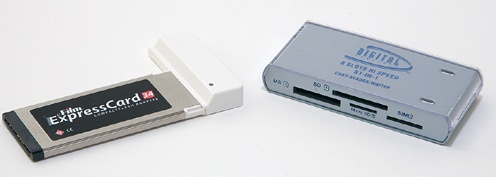Every image you shoot is stored on your camera's media card as an individual file. The file is a document just like you might create on your computer. Before you can do any editing of your images using your computer, you have to copy those image documents from your camera's media card onto your computer's hard drive.
You can transfer images from your camera in two ways. You can plug the camera directly into your computer, or you can remove its media card and place it in a media reader that is connected to your computer.
The advantage of a card reader is that it doesn't consume any of your camera's battery power. Also, most card readers support lots of different formats, so if you have more than one camera (say, the XS and a small point-and-shoot) that use different formats, then you need to carry only one card reader and a cable.
Depending on the type you get, a card reader might provide faster transfer than the XS. You should be able to find card readers that connect to your computer's USB 2 or FireWire port.
If you have a laptop with a PC Card slot or a CardBus 34 slot, then you can get card readers that will fit in those slots. These are typically the fastest readers of all, but they rarely support multiple formats.
Figure 4-2. On the left is a CardBus card reader that can plug directly into a CardBus slot on a laptop. On the right is a card reader that plugs into a USB 2 slot. Note the huge number of card formats that it supports.
REMINDER: Don't Forget SDHC
If you're shopping for an SD card reader, be sure to get one that also supports SDHC. Since the XS supports SDHC, you might end up buying SDHC cards at some point, so you might as well have a reader that can handle them as well as regular SD.
The XS also ships with a USB cable that you can plug directly into your computer. This allows you to use your camera as a card reader, saving you the hassle of keeping track of an extra piece of gear. However, if you have an especially speedy reader, transferring from the camera might be slower, and as mentioned before, camera transfer will use up battery power.
QUESTION: What If the Reader Can't Read My Card?
Sometimes you might find that a card that has always worked fine in your card reader suddenly won't read. If this happens, put the card back in the camera and see whether you can view images on the camera's screen. If you can, then you know that the camera can read the card just fine. Plug the camera into your computer and try transferring the images that way. It will usually work. When you're done, perform a low-level format (explained in Chapter 3). This will usually get the card working with your card reader again.
What happens on your computer when you plug in a card reader or camera will vary depending on the operating system that you're using. In the next two sections we'll go over the separate options available for Windows and Mac users.
Get The Canon EOS Digital Rebel XS/1000D Companion now with the O’Reilly learning platform.
O’Reilly members experience books, live events, courses curated by job role, and more from O’Reilly and nearly 200 top publishers.


